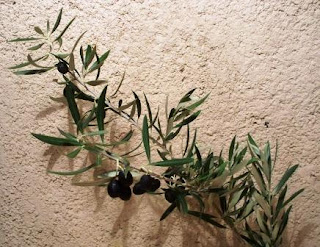 First a word about our olives. Many olive trees were planted in our area years and years ago as part of a state-wide project to promote interest in olive farming. Nothing was ever done about an olive infrastructure and so one by one the trees were cut down to make room for more pecan trees. A few of the trees on Ha de Perote were a little more stubborn than usual. They sent out limbs from the stump and now, years later, we are the first ones to harvest a crop.
First a word about our olives. Many olive trees were planted in our area years and years ago as part of a state-wide project to promote interest in olive farming. Nothing was ever done about an olive infrastructure and so one by one the trees were cut down to make room for more pecan trees. A few of the trees on Ha de Perote were a little more stubborn than usual. They sent out limbs from the stump and now, years later, we are the first ones to harvest a crop.As you can see, the trees have had no pruning management and most of the olives are hanging in the sky. While I picked the low hanging fruit - literally - Stanley climbed to the heavens for the largest part of our harvest.

This photo shows how the olives grow either singly or in small clusters. Most of the olives were black at picking, but there were still a few green ones.

Being totally inedible when harvested, olives are put through one of several "treatments." Not being the sort of person who willingly plays with lye, I opted for the hard-pack salt regimen.
First, the olives are sorted. All damaged olives are discarded.
 Normally, whole olives are packed in the coarse salt, but pressed for time before our autumn vacation, we tried to speed up the process by cutting a slit in each olive and extracting the seed.
Normally, whole olives are packed in the coarse salt, but pressed for time before our autumn vacation, we tried to speed up the process by cutting a slit in each olive and extracting the seed.
The olives are packed in salt . . .

Lots of salt - about 1/2 and 1/2.
We have approximately 5 1/2 pounds of olives in this container. It must be shaken - not stirred - once a day until "done." What's "done"? I assume the olive is done when it tastes good after washing off the salt.
A friend asked me what I would do with a cured olive. The short answer is "A lot more than you can do with a sick one."
I hope ours are fabulous. More about this later.